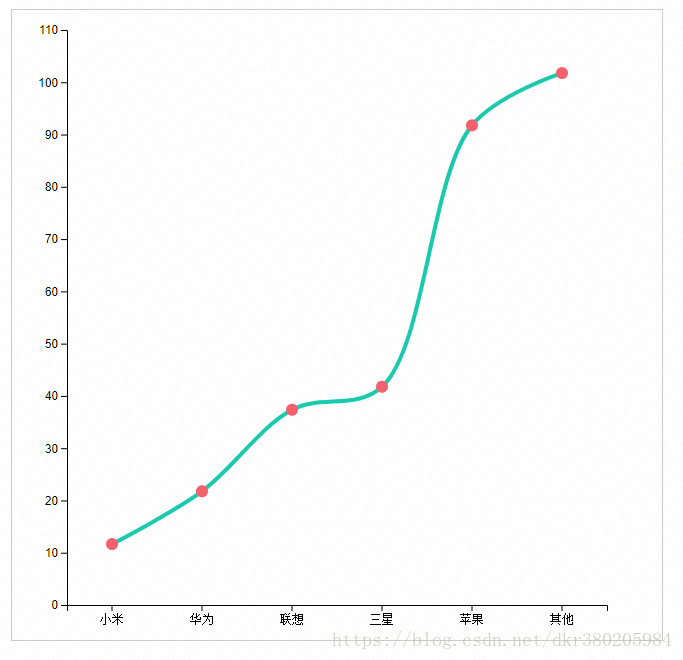
折线图参考echarts示例:http://www.echartsjs.com/examples/editor.html?c=line-smooth
折线图github地址:https://github.com/dkr380205984/myComponent/blob/master/src/page/d3/line.vue
d3制作折线图的难点在于如何实现折线图的动画效果
由于折线是由path标签绘制生成的,路径的信息都记录在同一个标签中,因此你想要绘制路径的过程变成动画显然需要借助svg本身的API,未找到相关资料。
所以需要剑走偏锋,换一个角度去实现。
在这里我提供两种实现折线图动画的设计思路。
第一种:利用SVG中stroke-dasharray及stroke-dashoffset属性(这两个属性介绍的传送门)
stroke-dasharray属性用来设置描边的点划线的图案范式。就是设置实线和虚线的宽度
stroke-dashoffset则指定了dash模式到路径开始的距离,就是实线虚线绘制的起点距路径开始的距离
我们可以利用这两个属性完成画线的效果。思路大概如下
把实线长度用stroke-dasharray设为折线段的长度,同时通过stroke-dashoffset设置偏移量为相等的值,这个时候这个折线段就完全偏移到你看不见的地方去了,然后通过动画属性将stroke-dashoffset的值从长度过渡到0,就能实现画线的效果。
事实上在上述步骤中,我们会用到折线段的长度,目前没有找到API提供方法获取折线段的长度,因此我们只能通过先绘制一条折线(不显示),然后用dom的方式去获取长度,这种做法十分愚蠢,如果有好的解决方案可以在下面留言。
// 透明折线绘制完成后,我们可以获取到长度了
let path = document.getElementsByClassName('line')
let length = path[0].getTotalLength()第一种方案用起来比较复杂,下面提供 一种简单的思路,这种方法在区域图中也用到了,而且看起来效果还不错。
设计思路:我们用一个rect(白纸)把除了坐标轴的信息都遮挡住,然后再让这张白纸像幕布一样慢慢的拉开,就完成上述效果了。具体效果可以看下一章的区域图,有兴趣的童鞋可以自己试一下。下面是折线图的源码(带详细注释)
<template>
<div id = "line"></div>
</template>
<script>
import * as d3 from 'd3'
export default {
data: function () {
return {
data: [{
name: '小米',
value: 10.7
}, {
name: '华为',
value: 20.8
}, {
name: '联想',
value: 36.4
}, {
name: '三星',
value: 40.8
}, {
name: '苹果',
value: 90.8
}, {
name: '其他',
value: 100.8
} ],
width: '',
heigth: '',
padding: {
left: '30px',
right: '30px',
top: '5px',
bottom: '20px'
}
}
},
methods: {
getStyle: function (obj, attr) {
if (obj.currentStyle) {
return obj.currentStyle[attr]
} else {
return document.defaultView.getComputedStyle(obj, null)[attr]
}
}
},
mounted () {
let _this = this
let dom = document.getElementById('line')
// dom容器宽高,参数padding获取
let width = parseFloat(this.width) || parseFloat(this.getStyle(dom, 'width'))
let height = parseFloat(this.height) || parseFloat(this.getStyle(dom, 'height'))
let padLeft = parseFloat(this.padding.left)
let padRight = parseFloat(this.padding.right)
let padTop = parseFloat(this.padding.top)
let padBottom = parseFloat(this.padding.bottom)
let minHeight = parseFloat(this.minHeight) || 0
if (isNaN(width) || isNaN(height)) {
console.error('width 或 height 参数错误')
return
}
// 检查padding参数是否有问题
if (isNaN(padLeft) || isNaN(padRight) || isNaN(padTop) || isNaN(padBottom)) {
console.error('padding 参数错误')
return
}
// 开始绘图,创建svg画布
let svg = d3.select('#line')
.append('svg')
.attr('width', width)
.attr('height', height)
// 创建x比例尺
let xData = _this.data.map((d) => d.name)
let xScale = d3.scaleBand().domain(xData).range([0, width - padLeft - padRight])
let xAxis = d3.axisBottom().scale(xScale)
// 绘制x轴
svg.append('g')
.attr('transform', 'translate(' + padLeft + ',' + (height - padBottom) + ')')
.call(xAxis)
.style('font-size', '12px')
// 创建y比例尺
let yData = _this.data.map((d) => d.value)
let max = d3.max(yData)
let yScale = d3.scaleLinear().domain([0, max]).range([height - padTop - padBottom, minHeight]).nice()
max = yScale.domain()[1]
let yAxis = d3.axisLeft().scale(yScale)
// 绘制y轴
svg.append('g')
.attr('transform', 'translate(' + padLeft + ',' + padTop + ')')
.call(yAxis)
.style('font-size', '12px')
// 让我们来做一个动画吧~~~~~~
// 设置折线路径
let line = d3.line()
.x(function (d, i) {
// 这里用xScale会有问题
return padLeft + (width - padLeft - padRight) / _this.data.length * (i + 0.5)
})
.y(function (d, i) {
return yScale(d.value)
})
// 这里有很多平滑曲线的种类可以选择,如最常用的d3.curveBasis,我找到一种可以把点绘制在线上的,当然还有很多其他方法
.curve(d3.curveCatmullRom)
// 绘制一条透明的折现,这条折线用于后续折现的长度获取,获取长度后就可以做动画了
svg.append('path')
.attr('stroke', 'rgba(0,0,0,0)')
.attr('stroke-width', '4px')
.attr('fill', 'none')
.attr('class', 'line')
.attr('d', line(_this.data))
.attr('class', function (d) {
return 'line'
})
// 透明折线绘制完成后,我们可以获取到长度了
let path = document.getElementsByClassName('line')
let length = path[0].getTotalLength()
// 获取到长度后,我们再绘制一条肉眼看得到的线
svg.append('path')
.attr('stroke', '#19CAAD') // 我们只需要设置线条颜色就够了
.attr('stroke-width', '4px')
.attr('fill', 'none') // 要把填充设置为none
.attr('class', 'line')
.style('stroke-dasharray', length)
.style('stroke-dashoffset', length)
.style('animation', 'dash 2s forwards')
.attr('d', line(_this.data))
.attr('class', function (d) {
return 'line'
})
// 我们还需要把dash添加到style中去
let rule = '@keyframes dash {0%{stroke-dashoffset:' + length + ';}100%{ stroke-dashoffset: 0;} }'
let style = document.createElement('style')
style.type = 'text/css'
style.innerHTML = rule
document.getElementsByTagName('head')[0].appendChild(style)
// 动画部分到此为止~~~~~~~~~~ 蠢的法力无边
// 这里有另外一个比较简单的解决思路,加遮罩,遮罩的动画会比弧好做的多,这里不做演示,仅供参考
// 绘制点的位置
let circle = svg.selectAll('.circle')
.data(_this.data)
.enter()
.append('circle')
.attr('class', 'circle')
.style('fill', '#F4606C')
.attr('r', 0)
.attr('cx', function (d, i) {
return padLeft + (width - padLeft - padRight) / _this.data.length * (i + 0.5)
})
.attr('cy', function (d) {
return yScale(d.value)
})
// 给circle加动画
circle.transition()
.delay(function (d, i) { return i * 200 })
.duration(1000)
.attr('r', 6)
// 给circle加鼠标事件,添加tooltips
let toolTips = d3.select('body').append('div')
.attr('class', 'toolTips')
.style('opacity', 0)
.style('position', 'absolute')
circle.on('mouseover', function (d) {
d3.select(this)
.transition()
.duration(400)
.attr('r', 10)
})
circle.on('mousemove', function (d) {
let html = `<div class="clearfix"><div class="border" style="background:'#F4606C'"></div><span>${d.name}:${d.value}</span></div>`
let mouseX = d3.event.clientX + 30
let mouseY = d3.event.clientY - 30
// 如果你的style用了scoped,那你的样式应该写到App.vue中去,否则插入元素的样式不会生效
toolTips.html(`<div class="tolTp">${html}</div>`)
.style('opacity', 1)
.style('left', mouseX + 'px')
.style('top', mouseY + 'px')
})
circle.on('mouseout', function (d) {
d3.select(this)
.transition()
.duration(400)
.attr('r', 6)
toolTips.style('opacity', 0)
toolTips.html('')
})
}
}
</script>
<style lang="less">
#line{
width: 600px;
height: 600px;
margin: 20px 20px;
padding: 15px 25px;
border:1px solid #cccccc;
position: relative;
}
.tolTp{
padding:8px 12px;
background: rgba(0, 0, 0, 0.7);
color:white;
.border{
width: 6px;
height: 6px;
border-radius: 3px;
background: #83bff6;
float: left;
margin:7px 8px 7px 0;
}
span{
float: left;
line-height: 20px;
}
}
</style>



















